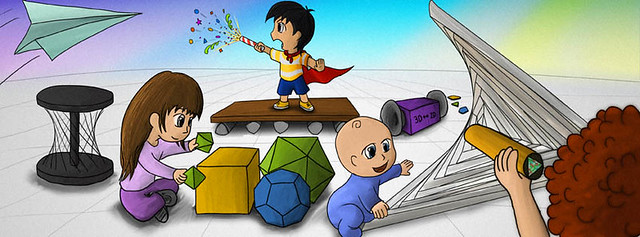Cover art & glossary: Newsletter November 30, 2012

Welcome to adventurous math for the playground crowd! I am Moby Snoodles, and I love to hear from you at moby@moebiusnoodles.com
Book news
The book cover is almost ready! Do you like it? What would you change?
This week, we’ve been working on a glossary of main terms. We wanted each definition…
- Mathematically correct
- Accessible to math-anxious people
- Engaging for mathy people
- To have a clear example
- To have a clear counter-example
This is surprisingly challenging! We like how our definitions turn out, though. Check out these examples.
Function
Functions are machines that convert values to other values, or find correspondences between values. Function machines work by rules people make up. The starting values are called input. The converted or corresponding values are called output. The rule must find a single output for each input. Your stove is a function machine: it starts with the input of raw eggs, milk and spices, and makes the output of an omelet. The fantasy machine that starts with the same input and makes either omelets or live chickens is not a function.
Inverse Function
What a function does, the inverse will undo. Of course, some deeds cannot be undone. The function of “baby drops a cup of grapes on the floor” has an inverse, “parental unit crawls around, searching for grapes and putting them back into the cup”. On the other hand, the function of “drop a cup of orange juice on the floor” and the function “break an egg for an omelet” do not have inverses.
Cycle
Cycles are sequences of objects or series of operations that repeat. For example, “winter, spring, summer, autumn” is the cycle of seasons that repeats every year. There are cyclic stories and songs, like “99 bottles of beer.” Many household tasks are cyclic, such as washing dishes – “lather, rinse, repeat.” Cycles relate to recursion and iteration. Not all infinite sequences have cycles; for example, there are no cycles in the digits of Pi.
The mindmap for the glossary helps to see relationships between ideas. And it drives home the message that math is not linear.
Sharing
You are welcome to share the contents of this newsletter online or in print. You can also remix and tweak anything here as you wish, as long as you share your creations on the same terms. Please credit MoebiusNoodles.com
More formally, we distribute all Moebius Noodles content under the Creative Commons Attribution-NonCommercial-ShareAlike license: CC BY-NC-SA
Talk to you again on December 15th!
Moby Snoodles, aka Dr. Maria Droujkova
Related Posts
Posted in Newsletter









Leave a Reply